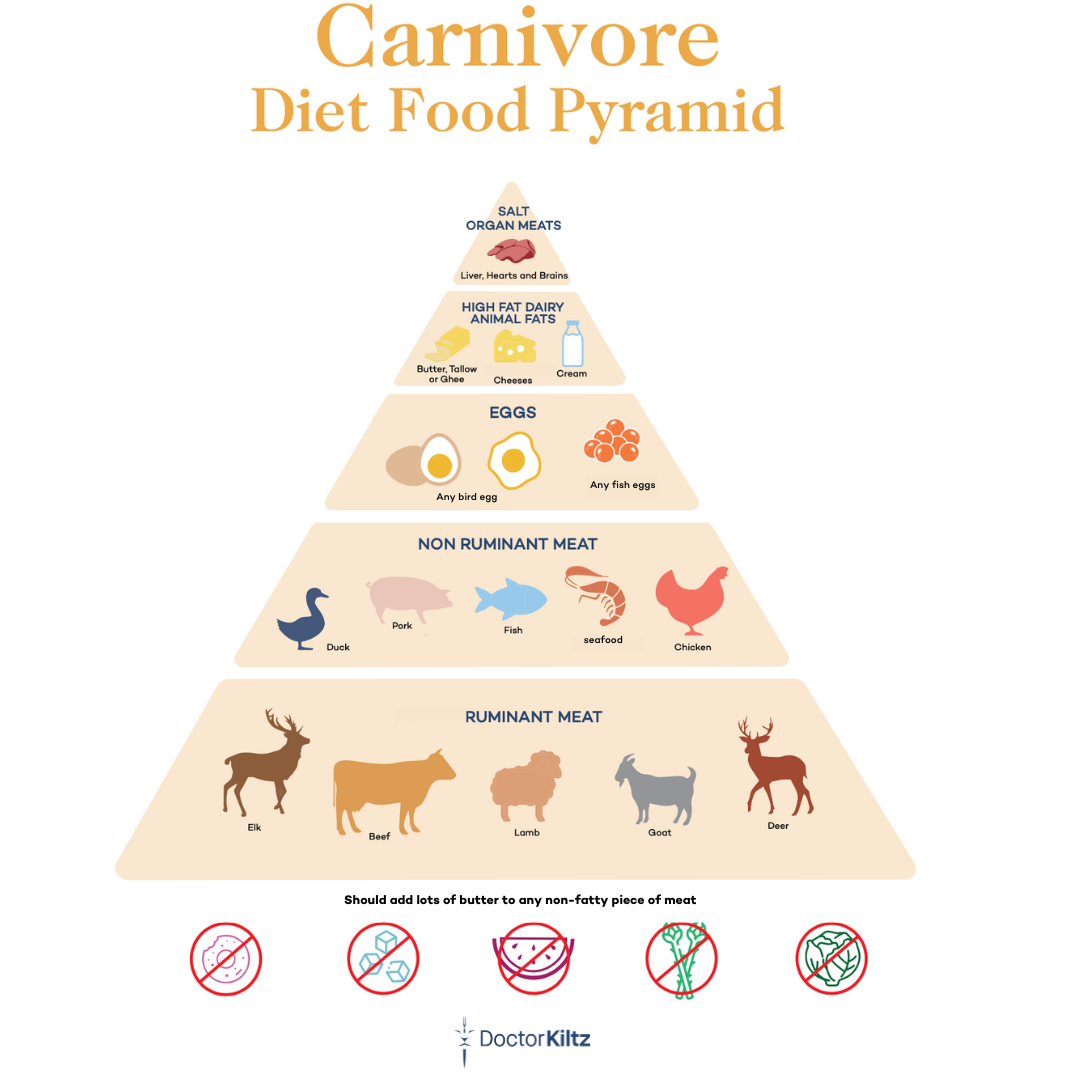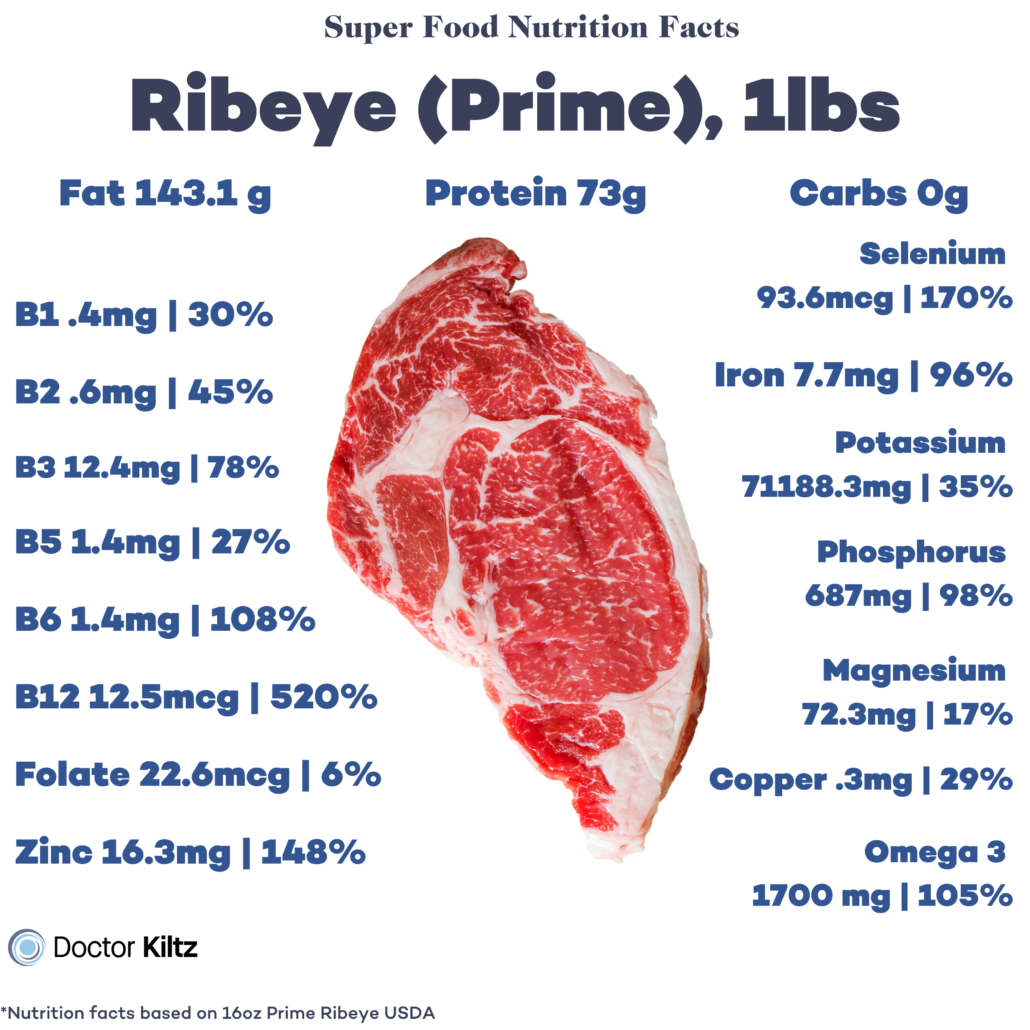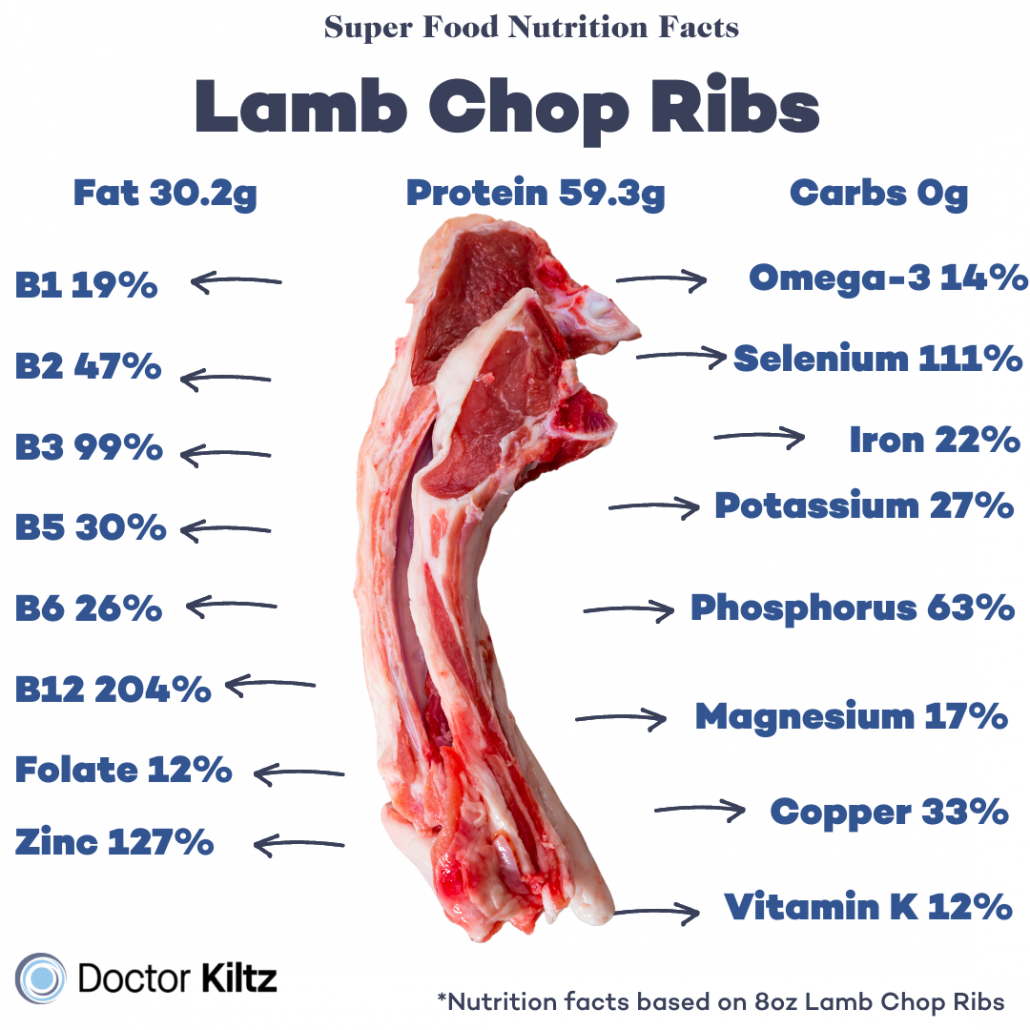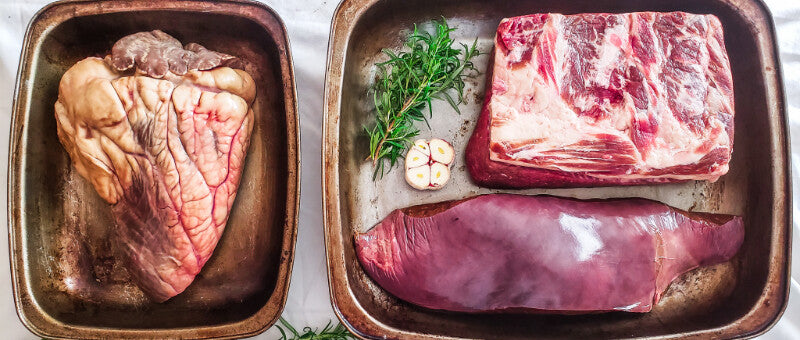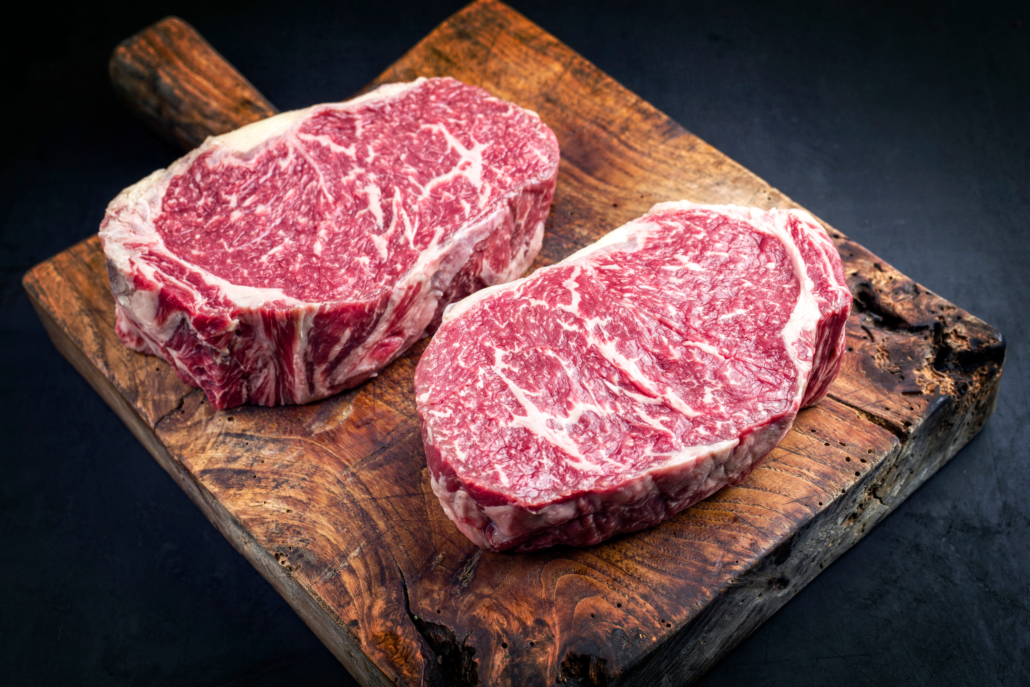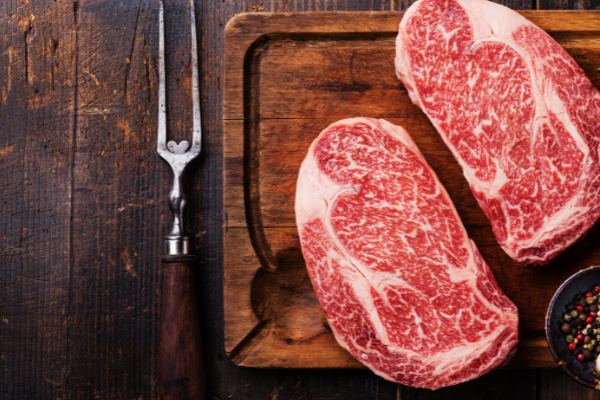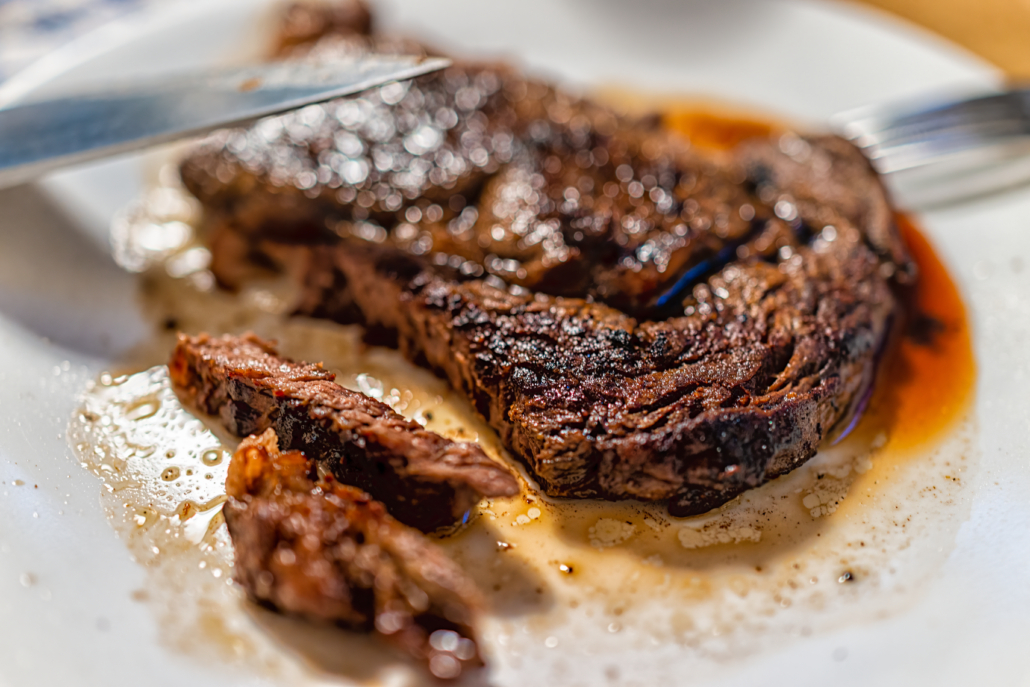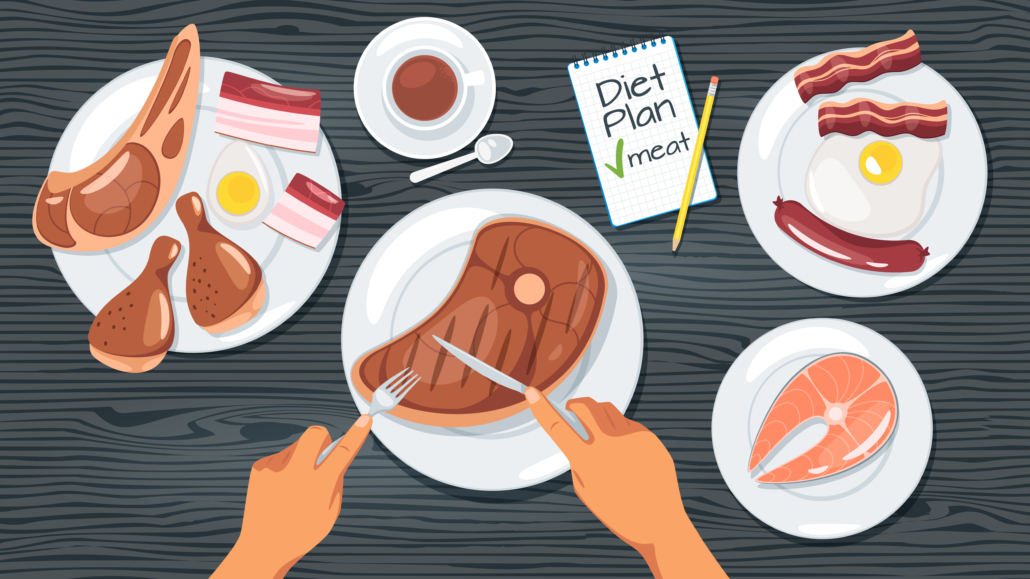We include products in articles we think are useful for our readers. If you buy products or services through links on our website, we may earn a small commission.
Carnivore Diet Food List: What to Eat On the Carnivore Diet
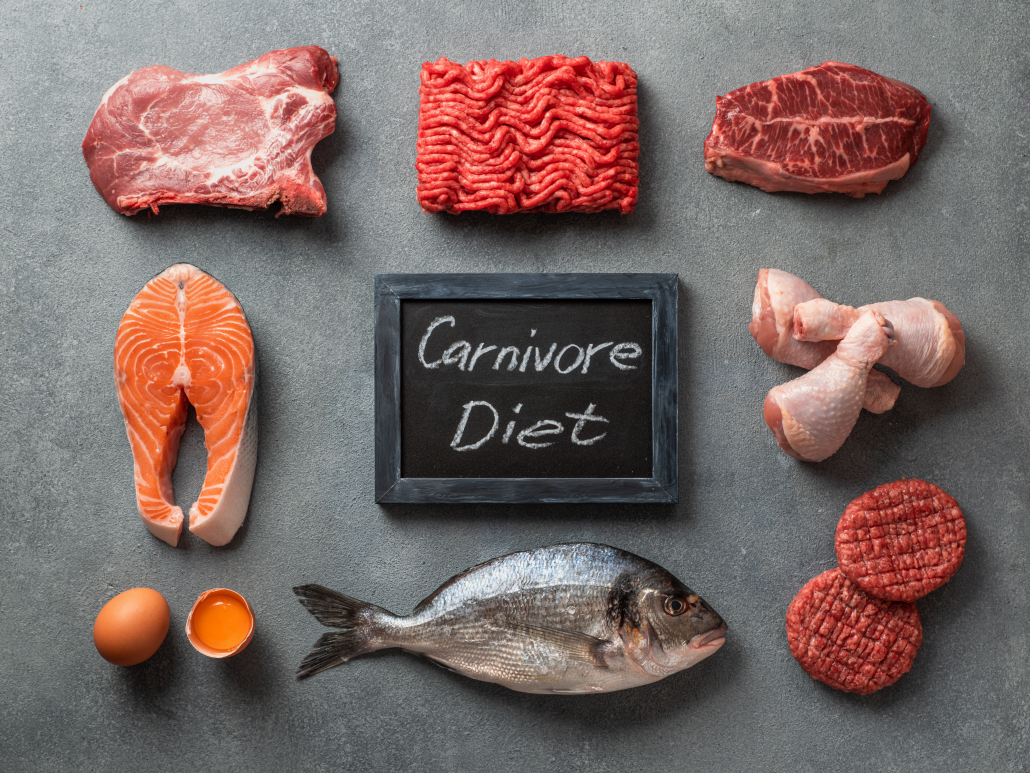
An exclusively animal product carnivore diet might sound restricting, but as you’ll see, there’s a surprising variety of carnivore diet foods that can make it on your shopping list.
In this article, we’ll explore what to eat on a carnivore diet, along with the macro and micronutrient properties of the most nutritional animal-based foods.
This carnivore diet food list is here to help you formulate the most nutritiously robust diet to meet your personal health goals.
Table of Contents
What is the Carnivore Diet
The carnivore diet is among the simplest diets out there. As its name implies, the carnivore diet means eating 100% animal foods. No fruits, vegetables, bread, grain, nuts, or seeds. All foods must be sourced from animals. Some people even take it so far as only using animal-based products on their skin!
Most carnivores base their food lists around fresh ruminant meat, and consider animal products like A2 dairy, eggs, fair game.
The carnivorous way of eating may seem unorthodox, but it’s actually based on how our ancestors ate for 2 million years. The low-calorie superfoods touted today simply wouldn’t have been worth the effort to the hunter-gatherers of millennia past.
Let’s look at an overview of what you can and can’t eat on a carnivore diet, then get into the specific foods on the list.
Food You Can Eat on a Carnivore Diet
One of the major pluses of a carnivore diet is how easy it is to shop for. Here’s a list of nurturing animal-based foods to enjoy:
- Meat: Choose fatty cuts of ruminant grass-fed meat like ribeye and NY strip steak, 80/20 ground beef, t-bone, lamb, and goat. For pork, choose pasture-raised, and fatty cuts like pork belly.
- Fat: A key to remember is that your body will be using fat as its main energy source, not protein. Fat is your friend. That white stuff surrounding the meat is nutritional gold! Tallow and lard, are saturated, molecularly stable fats that are perfect for cooking even at high heat. They’re also great for enjoying on their own to boost your fat intake.
- Organ meats: Nature’s true superfoods, organ meats provide substantial amounts of bioavailable essential macronutrients like vitamins A, E, K2, D, and C. Liver in fact is so nutritious it may be best enjoyed as a supplement. Other organ meats include kidney, pancreas, brains, tongue, tribe, and bone marrow. On a carnivore diet, organs can make the difference between thriving and mineral deficiencies.
- Seafood: As with meat, go for the fattiest you can find. King salmon has its name for a reason, though it can get expensive. Coldwater fish like sardines and trout are also a great option. Prawns, oysters, and scallops are also excellent sources of healthy cholesterol, proteins, and hard-to-get minerals.
- Eggs: A total food on their own, eggs have nearly every nutrient your body needs.
- A2 dairy: Always choose full-fat dairy and cow’s milk labeled A2. Other naturally A2 dairy is from goats, sheep, and buffalo. For butter and ghee, go grass-fed. Though cheese is technically allowed on some versions of the carnivore diet, it is likely best to eliminate it, at least in the beginning, then observe your digestion if it’s re-introduced.
- Bone Broth contains gelatin, electrolytes, and a robust list of amino acids that can help reduce any risks associated with red meat, maintain healthy bowel movements, and support joint and skin health.
- Salt, pepper, and a few herbs on some version of the carnivore diet. Salt in particular is crucial in the transitional phase when your body burns up stored glycogen that gets flushed out in the urine.
Foods to Eliminate on a Carnivore Diet
On all versions of the carnivore diet, you are restricted to only animal-based foods. This means no:
Carnivore Diet Fats
Because a carnivore diet offers almost no carbohydrates, your body will enter ketosis. This means that your body will switch from using glucose (blood sugar) to breaking down fatty acids into ketones to fuel most of the cells in your body.
To give your body the fuel it needs, you’ll need to eat a lot of fat. The ideal ratio is 3 parts fat to 1 part protein, or 75% of your calories from fat.
Relying too much on the lean muscle meats that most of us are used to can lead to protein poisoning. This is a potentially serious problem that occurs when the liver can’t upregulate urea synthesis it needs to process high amounts of protein.
So remember on a carnivore diet, fat is your friend!
Fat from ruminant animals, pasture-raised pork, and full-fat dairy all feature high percentages of healthy, heat-stable saturated fats. These fats also feature low percentages of heat-sensitive and potentially inflammatory partially unsaturated fats (PUFAs).
Let’s take a closer look at some key features of each.
Beef Tallow
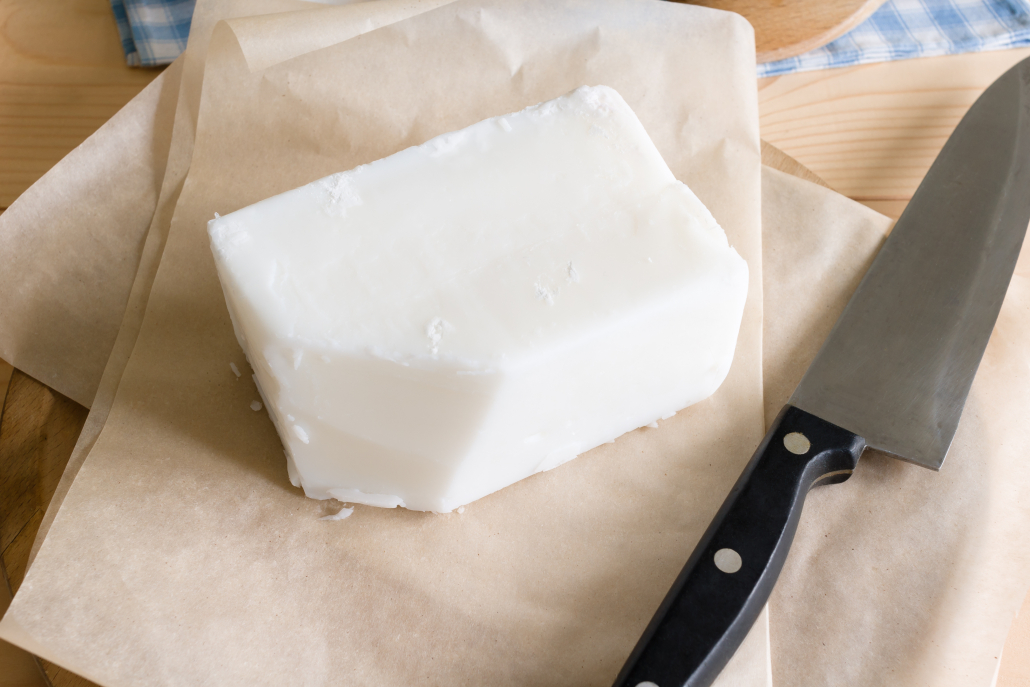
The long-chain saturated fats in beef tallow support healthy cell membranes and play a role as signaling molecules. Eating more saturated fat can saturate your cell membranes, protecting your cells from glycation, oxidation, endotoxin buildup, and other cellular stressors.
Lard
As with beef tallow, lard offers numerous essential and heat-stable fatty acids. In addition, pastured lard from pork that is allowed to bask in the sunshine is one of the best vitamin D sources on earth. Lard from pasture-raised pigs can be as high in vitamin D as cod liver oil, and may be higher in other fat-soluble vitamins.
Butter
Butter, especially from grass-fed cows, is loaded with beneficial nutrients like conjugated linoleic acid (CLA), butyrate, vitamins, and minerals. Research shows that eating butter can reduce your risk of diabetes, obesity, and heart disease.2 Butter is also linked to improved sleep 3, immune function, and fertility.
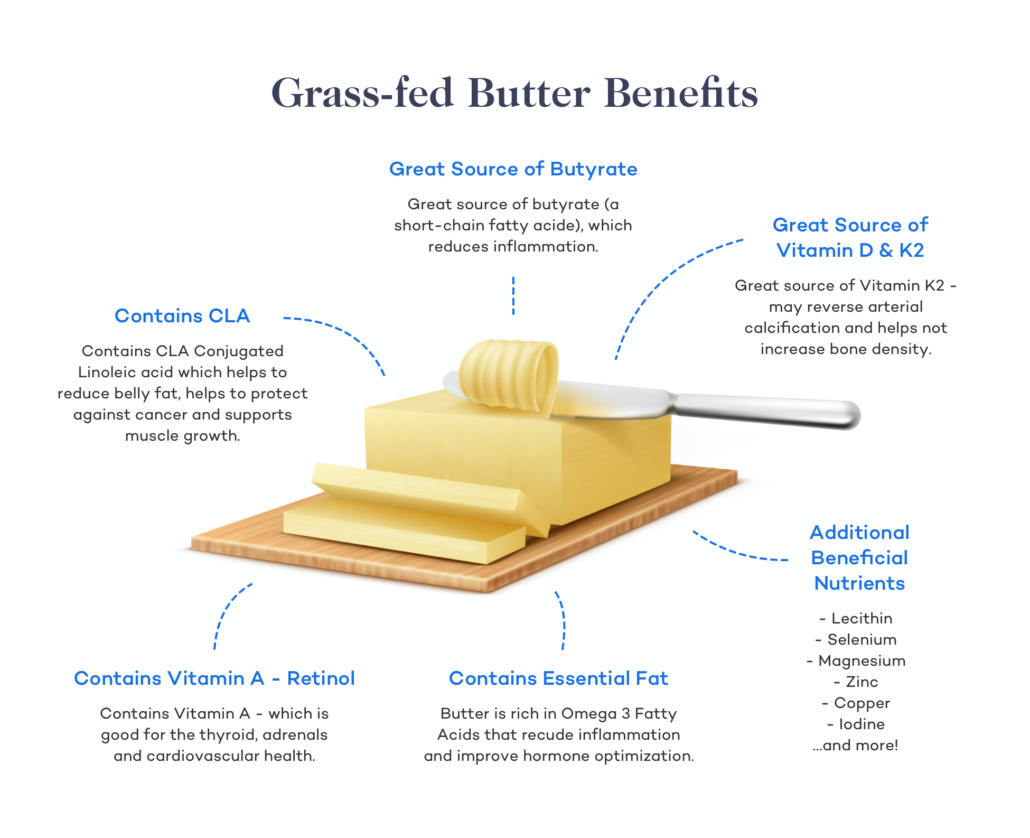
Ghee
Ghee can bring all the full-fat dairy benefits of butter, with the added ability of withstanding higher temperatures. With a smoke point of 465°F, ghee has an 80° higher tolerance than any other cooking oil! And if you’re still falling for the outdated anti-saturated fat scare tactics, a 2018 study of 200 people in India found that participants who ate more ghee and less vegetable oil had healthier blood cholesterol markers.
Duck Fat
Duck fat is tasty, and studies by French researchers (of course) show that duck fat may also increase overall cardiovascular health. 2 Duck fat is also high in linoleic acid, along with certain antioxidants that can reduce premature aging and support bone health. However, duck fat is higher in unstable PUFAs which allows it to oxidize faster than other carnivore diet fats listed here.2 Oxidized fat can cause inflammation.
Heavy Cream
Like butter, full-fat cream is loaded with fat-soluble vitamins and minerals. Just ⅓ cup of heavy cream offers 35% of vitamin A, 10% of vitamin D, and 7% of Vitamin D. Studies show that consuming full-fat dairy is associated with a decreased risk of obesity, type 2 diabetes, and heart disease.
For those of you still scared of full-fat dairy: A large-scale review including more than 3.6 million participants found that high-fat dairy products are not associated with any causes of mortality.
Nutrition info per 1 tablespoon
| Type | SFA% | PUFA % | Carbs | Total Fat | Notes |
| Beef Tallow | 49.8 | 3.1 | 0g | 12.8 | Mild beef flavor Can be heated |
| Lard | 41 | 12 | 0g | 13g | Mild flavor Can be heated |
| Butter | 50 | 3.4 | 0g | 12g | Mildly Sweet Lower Heat |
| Ghee | 48 | 5 | 0g | 9g | Mild nutty flavor Can be heated |
| Duck Fat | 25 | 13 | 0g | 13g | Rich Duck flavor Can be heated |
| Heavy Cream | 62 | 4 | .5g | 5.4 | Sweet and rich |
Beef

Beef is loaded with nutrients in the near perfect ratio for our body’s needs, and in highly bioavailable form.
In addition to healthy fats and proteins, beef also contains unique compounds that are hard to find anywhere else, these include:
- Carnitine: plays a significant role in improving male fertility. [6] Reduces anemia, especially when co-occurring with kidney dysfunction. [7] Supports mitochondrial function and insulin sensitivity for people with type 2 diabetes. [8] Can prevent ischemia in cardiac muscle. [9]
- Carnosine: Anti-aging. Protects heart and muscles[2][3]. Prevents glycation–the destructive bonding of glucose to your cells and DNA. [4] Antioxidant properties destroy free radicals and reduce damage and shortening of telomeres. [5]
- Creatine: Improves cognitive function. [10] Enhances athletic performance. [11] Alzheimer’s patients show low creatine levels. [12] improves cardiovascular performance and glycemic control. [13]
- Taurine: A powerful antioxidant. Reduces glycation, inflammation, and oxidative stress. Anti-depressive effects in animal studies.
- Zinc: protects against coronary artery disease, is essential in insulin formation, and has been shown to increase glycemic control for diabetics., [18] [19] Zinc in beef is 400% more bioavailable than the zinc you get in breakfast cereals. [15] Low levels of zinc are associated with lower sperm count and erectile dysfunction in males. [14]
- Vitamin B12: Exclusively found in animal products. Deficiency in B12 can lead to dementia and Alzheimers disease. [21] Has been shown to significantly reduce depressive symptoms.
- Heme Iron: Only found in beef and other red meat. Lack of iron leads to anemia. Plays a key role in immune function, cognition, and energy metabolism.
Beef Nutrition
When choosing your beef select grass-fed and finished or pasture-raised when possible. And keep in mind that fattier cuts will keep in the ideal fat-protein ratio to fuel your cells. The list below details 10 of the most popular cuts of beef.
Nutrition Info per 4 oz.
| Beef Cut | Calories | Fat | Protein | Carbs | % Calories from fat | % Calories from protein |
| Boneless short ribs | 440 | 41 | 16 | 0 | 84 | 15 |
| Tri-tip roast | 340 | 29 | 18 | 0 | 77 | 21 |
| Beef Back Ribs | 310 | 26 | 19 | 0 | 75 | 25 |
| Ribeye | 310 | 25 | 20 | 0 | 73 | 26 |
| Porterhouse | 280 | 22 | 21 | 0 | 70 | 30 |
| Top Sirloin | 240 | 16 | 22 | 0 | 60 | 37 |
| 80/20 Ground Beef | 307 | 19.6 | 30.5 | 0 | 59 | 41 |
| Skirt Steak | 265 | 16.5 | 27 | 0 | 58 | 42 |
| Brisket | 245 | 14.7 | 28 | 0 | 54 | 46 |
| Flank Steak | 200 | 8 | 32 | 0 | 36 | 64 |
Let’s take a look at the nutrient profile of one of the tastiest cuts of beef: rib eye
| NUTRIENT | 226G RIB EYE | RECOMMENDED DAILY VALUE (RDV) | % RDV |
| CALORIES | 655 cal | 2500 | 18.6% |
| PROTEIN | 54g | 60g (Standard Diet, not Keto) | 90% |
| FAT | 50g | 30g (Standard Diet, not Keto) | 166% |
| SATURATED FAT | 23g | 20g (Standard Diet, not Keto) | 115% |
| MONOUNSATURATED FAT | 25g | ||
| CARBOHYDRATES | 0g | 1200g (Standard Diet, not Keto) | 0% |
| NIACIN (B-3) | 13.5mg | 16mg | 30% |
| B-6 | 1.4mg | 2mg | 70% |
| SELENIUM | 56.25 mcg | 67mcg | 84% |
| IRON | 3.24mg | 20mg | 16% |
| MAGNESIUM | 144mg | 420mg | 34% |
| ZINC | 9.45mg | 11mg | 86% |
| POTASSIUM | 666mg | 4000mg | 17% |
| PHOSPHORUS | 400mg | 700mg | 57% |
Pork
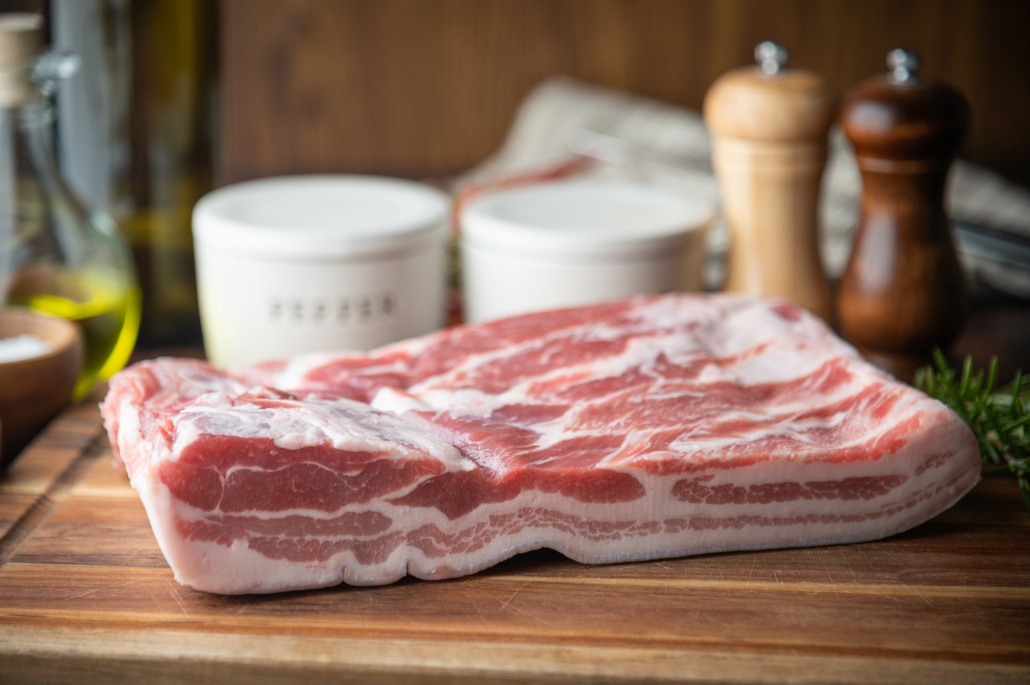
On a carnivore diet, ruminant animals like beef and lamb are given a primary role, while pork is often viewed as a second or third option. Some of the reasons for this include:
- Pork has less nutrient density than most cuts of red meat from ruminant animals
- Pigs can’t metabolize the inflammatory omega 6 fats they get from their feed, into omega-3s, but ruminant animals can
- It can be difficult to find pasture-raised pork, and much easier to find grass-fed lamb, beef, and bison
But none of these points are reasons to leave pork out. Pork is delicious and loaded with healthy fats and proteins. It also offers high amounts of B vitamins along with hard-to-get micronutrients like selenium and choline.
But not all pork is created equal. Pasture-raised pork that’s allowed to soak up the sunshine is a fantastic source of vitamin D. As we saw above, pastured lard can be almost as high in vitamin D as cod liver oil.
Choline in Pork
Choline is one of the lesser known, but important compounds in pork. Bacon is one of the top five sources of dietary choline.
Choline maintains brain and nervous system function, regulates mood, and aids in memory. It also plays a key role in the formation of membranes around cells.
This unsung nutrient also offers greater antioxidant activity than Vitamin E. It’s the reason why lard resists rancidity–choline neutralizes the free radicals that would otherwise oxidize the fat. And oxidized fat can cause inflammation when consumed.
Nutritional information per 4 oz.
| Pork Cut | Calories | Fat | Protein | % Calories Fat | % Calories Protein |
| Pork Belly | 588 | 60 | 10.4 | 92 | 7 |
| Baby back ribs | 315 | 27 | 18 | 77 | 23 |
| Pork Hocks | 285 | 24 | 17 | 76 | 24 |
| Shoulder | 285 | 23 | 19 | 73 | 27 |
| Bacon | 600 | 47.2 | 41.9 | 71 | 28 |
| Butt | 240 | 18 | 19 | 68 | 32 |
| Leg Ham | 305 | 20 | 30.4 | 59 | 40 |
| Loin | 265 | 15.5 | 30.8 | 53 | 46 |
| Chop | 241 | 12 | 33 | 45 | 55 |
| Tenderloin | 158 | 4 | 30 | 23 | 76 |
Pork Belly Highlight
On a carnivore diet, it’s best practice to choose the fattiest cuts, and they don’t get fattier than pork belly.
Similar to bacon, pork belly comes from the hog’s underside. You can serve this boneless cut fresh, unlike bacon which is cured or smoked and therefore contains nitrites.
Fresh pork belly is loaded with quality fat, protein, and fat-soluble vitamins and minerals.
| PORK BELLY NUTRITIONAL CONTENT PER 224G | AMOUNT | % RDA |
| FAT | 89g | N/A |
| SATURATED FAT | 32g | N/A |
| MONOUNSATURATED FAT | 42g | N/A |
| POLYUNSATURATED FAT | 9g | N/A |
| OMEGA 3 ALA | 900mg | 100% |
| Protein | 20g | |
| CHOLINE | 113mg | 21% |
| VITAMIN B12 | 1.8mcg | 75% |
| PANTOTHENIC ACID (B5) | 2.5mg | 50% |
| NIACIN (B3) | 9mg | 56% |
| RIBOFLAVIN (B2) | .4mg | 32% |
| THIAMIN (B1 | .7mg | 56% |
| COPPER | .2mg | 22% |
| PHOSPHOROUS | 300mg | 24% |
| SELENIUM | 23mcg | 42% |
| ZINC | 1.7mg | 16% |
| VITAMIN D | 1.8mcg | 9% |
| IRON | .9mg | 5% |
Lamb
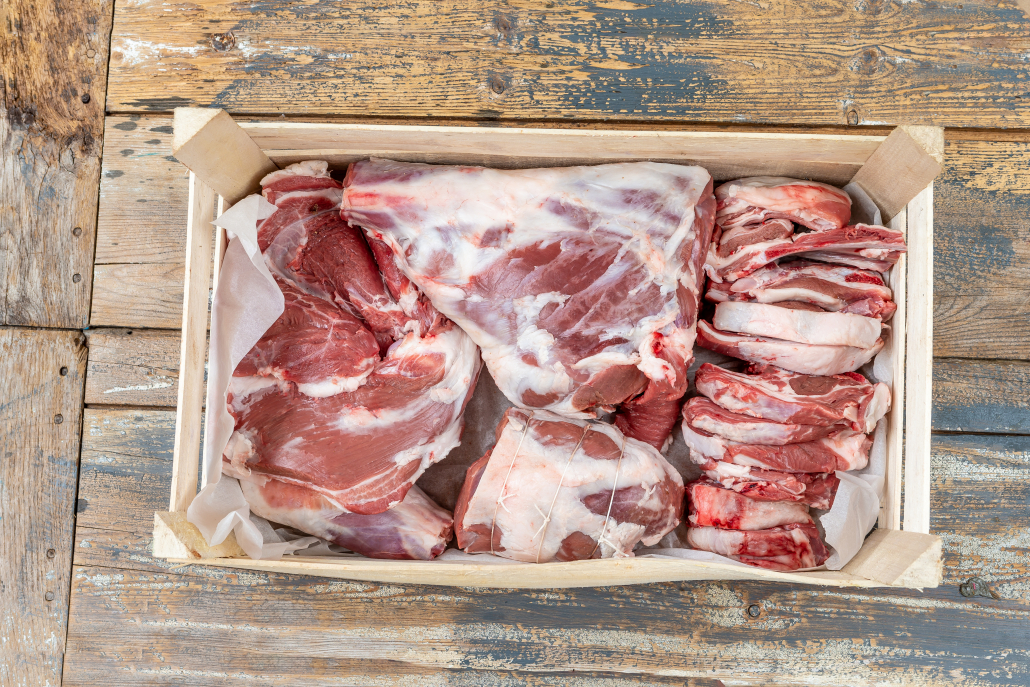
Lamb is a delicious ruminant meat that makes for a succulent treat on any carnivore diet food list. As with most other meats, lamb is rich in protein and healthy fats, along with bioavailable vitamins and minerals.
Lamb offers meat specific compounds like taurine and creatine, along with other vital nutrients, including:
- Vitamin B12: Important for brain function and blood formation.
- Zinc: An essential mineral for the synthesis of insulin and testosterone hormones.
- Niacin ( B3). Inadequate niacin has been linked to greater risk of heart disease
- Glutathione: An antioxidant with numerous positive impacts, including reducing insulin resistance, reducing oxidative damage in children with autism, reducing risk of autoimmune disease, and reducing symptoms of Parkinson’s disease. 2
- Conjugated linoleic acid (CLA). Found in higher levels in lamb than any other meat, this is a healthy trans fat, not to be confused with unhealthy trans fats made from processed vegetable oils like margarine. CLA has been shown to boost the immune system, strengthen bones, support a healthy heart and aid in fat loss.
Nutrition information per 4 oz.
| Lamb Cut | Calories | Fat | Protein | Carbs | % Calories from Fat | % Calories from Carbs |
| Chop/Rack | 330 | 22 | 30 | 0 | 63 | 37 |
| Loin Chop | 330 | 22 | 30 | 0 | 63 | 37 |
| Leg | 292 | 18.7 | 29.3 | 0 | 59 | 41 |
| Shank | 276 | 14.7 | 32 | 0 | 52 | 48 |
| Shoulder | 148 | 6 | 22.8 | 0 | 37 | 63 |
Lamb Chops Highlight
Let’s take a closer look at the nutrition facts for one of the most popular and delicious cuts of lamb–the chop or rack:
| Lamb Chops/Rack | ||
| Nutrients per 4 oz | Amount | % RDA |
| Fat | 22g | N/A on carnivore diet |
| Saturated Fat | 11g | N/A on carnivore diet |
| Trans Fat (CLA) | 1.5g | N/A on carnivore diet |
| Cholesterol | 92mg | |
| Protein | 30g | |
| B12 | 1.7µg | 72% |
| B3 | 8.9mg | 56% |
| B6 | .6mg | 46% |
| B2 (RIboflavin) | .4mg | 28% |
| B5 | .7mg | 13% |
| B1 | .2mg | 13% |
| Selenium | 15.2µg | 28% |
| Zinc | 3.3mg | 23% |
| Phosphorus | 216 mg | 22% |
| Copper | .1mg | 15% |
| Iron | 2.4mg | 13% |
Poultry
Though poultry is an animal food, it usually only accounts for a relatively small portion of the total caloric intake on a carnivore diet.
The main drawback to poultry is that it’s very lean compared to ruminants, pork, and even many seafood options.
It’s important to remember that a carnivore diet is essentially a zero-carb diet. This means your body relies on fat, not protein for fuel. To provide the necessary fat, aim for at least a 70-30 fat-to-protein ratio.
A quick tip for choosing the most nourishing poultry is to choose cuts that keep the skin on. And you can always cook your poultry in added healthy fats like duck and beef tallow.
There is also one part of poultry that is always encouraged: chicken liver.
| Poultry | Calories | Fat | Protein | Carbs | % Fat | % Carbs |
| Goose | 340 | 24.9 | 28.5 | 0 | 66 | 34 |
| Game Hen | 220 | 16 | 19 | 0 | 65 | 35 |
| Chicken Wings | 320 | 22 | 30.4 | 0 | 62 | 38 |
| Chicken thigh (skin on) | 275 | 17.6 | 28.3 | 0 | 58 | 41 |
| Duck | 228 | 13.9 | 26.3 | 0 | 55 | 46 |
| Chicken Leg (skin on) | 275 | 15.2 | 29.4 | 0 | 54 | 46 |
| Turkey | 175 | 9.9 | 21 | 0 | 51 | 49 |
| Chicken Breast (skin on) | 200 | 8.4 | 31 | 0 | 38 | 62 |
| Chicken Breast (skinless) | 138 | 4 | 25 | 0 | 26 | 72 |
Chicken Wings Highlights
Let’s look at the profile of one of the most nutrient-dense varieties of poultry on a carnivore diet food list:
| Chicken Wings | ||
| Nutrients per 4 oz | Amount | % RDA |
| Fat | 22g | N/A on carnivore diet |
| Saturated Fat | 7g | N/A on carnivore diet |
| Cholesterol | 111mg | |
| Protein | 30.4g | |
| Vitamin B6 | 0.5m | 41% |
| Vitamin B3 | 5.7mg | 36% |
| Choline | 82 mg | 15% |
| Vitamin B12% | 0.3µg | 10% |
| Vitamin B2 (Riboflavin) | 0.1mg | 8% |
| Selenium% | 17.6µg | 32% |
| Phosphorus | 123.0mg | 12% |
| Zinc | 1.2mg | 9% |
Fish
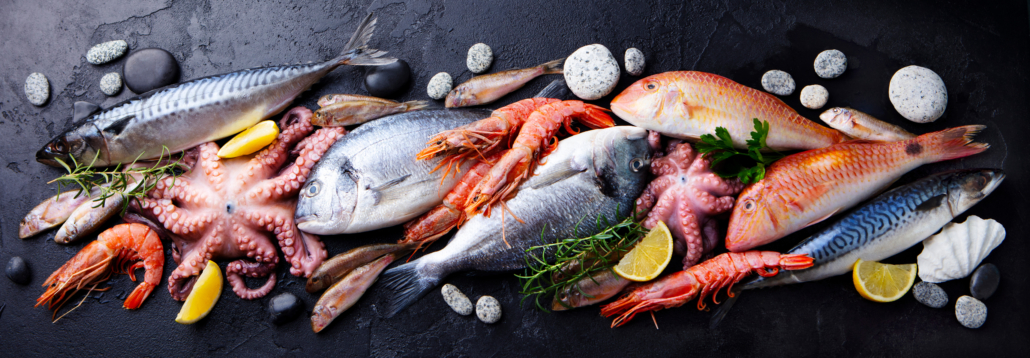
Fresh fish and seafood assortment on black slate background. Top view.
Fish are one of the most nutrient-dense classes of food on earth. Yet on the carnivore diet, it’s best to let fish play a supporting role to ruminant meats.
This is because most fish are relatively lean. Making lean protein the center of your diet can lead to fat shortages and even protein poisoning. There’s also the issue of fish toxicity. Almost all fish contain some amount of toxic compounds from pollution.
Interestingly, most ancestral cultures that ate a lot of seafood still got most of their fat from land-based animals. Or in the case of the Inuit, from fatty seafaring mammals.
That said, fish are a welcome addition to any carnivore diet food list. Below is a list of some of the most popular varieties.
Nutrition info per 100g
| Type of Fish | Calories | Fat | Protein | Carbs | % Calories from fat | % Calories from protein |
| Mackerel | 290 | 20.3 | 27 | 0 | 63 | 37 |
| Anchovies | 256 | 15.9 | 28 | 0 | 56 | 44 |
| Farmed Salmon | 234 | 14 | 25 | 0 | 56 | 44 |
| Wild King Salmon | 195 | 13 | 22 | 0 | 54 | 46 |
| Sardines | 139 | 7.5 | 18 | 0 | 49 | 52 |
| Arctic Char | 208 | 10 | 29 | 0 | 43 | 56 |
| Halibut | 155 | 3.5 | 30.7 | 0 | 20 | 79 |
| Seabass | 135 | 3 | 27 | 0 | 20 | 80 |
| Cod | 113 | 1 | 26 | 0 | 8 | 92 |
| Tuna (Yellowfin) | 150 | 1.5 | 34 | 0 | 9 | 91 |
| Tuna (canned) | 123 | .8 | 27.5 | 1.5 | 6 | 89 |
King Salmon Highlight
King Salmon, AKA chinook salmon, is the largest of the Pacific salmon species. They can reach over 100 pounds! It’s also the highest in fat of all wild salmon species. Widely considered the most delicious salmon, with a smooth buttery texture and mild flavor, it also has the highest amount of B vitamins.
King Salmon Highlights
| King Salmon (Wild) | Amount per 4 oz. | % RDA |
| Fat | 12g | |
| Saturated Fat | 2g | |
| Cholesterol | 61mg | |
| Protein | 20g | |
| Vitamins | ||
| Vitamin B12 | 7.4µg | 308% |
| B3 | 8.4mg | 53% |
| B6 | .3mg | 21% |
| B5 | 1gm | 21% |
| Vitamin A | 453.0IU | 15% |
| B1 | .2mg | 13% |
| B2 | .2mg | 13% |
| Vitamin E | 1.5mg | 10% |
| Minerals | ||
| Selenium | 31.0µg | 56% |
| Phosphorus | 208.0mg | 21% |
| Potassium | 370.0mg | 10% |
| Magnesium | 24.0mg | 6% |
Seafood
Seafood is an excellent way to add variety to your carnivore diet food list, both in terms of taste and nutrients. Oysters, for instance, are fantastic sources of zinc, and salmon roe is one of the few significant sources of vitamin C in animal foods.
Additionally, many types of seafood with orange pigment like lobster, roe (caviar), and shrimp, contain a powerful antioxidant compound called Astaxanthin. It may be 6,000 times more potent than vitamin C, and has been shown to reduce oxidative stress and protect the liver.
| Type of Seafood | Calories | Fat | Protein | Carbs | % Calories from fat | % Calories from protein | % Calories from carbs |
| Salmon Caviar (Roe) | 260 | 14 | 29 | 2.9 | 45 | 52 | 3% |
| Oysters | 58 | 1.9 | 6.5 | 3.1 | 29 | 33 | 28 |
| Mussels | 97 | 2.8 | 13.5 | 4.5 | 26 | 56 | 19 |
| Shrimp | 135 | 2.0 | 25.8 | 1.7 | 18 | 78 | 4 |
| Crab | 107 | 2.0 | 22 | 0 | 17 | 82 | 0 |
| Lobster | 116 | 1.8 | 25 | 0 | 14 | 86 | 0 |
| Clams | 82 | 1.1 | 15 | 3 | 12 | 73 | 15 |
| Scallops | 97 | 1.0 | 19 | 3 | 9 | 78 | 12 |
Salmon Roe Highlights
Also known as Ikura, red caviar, and salmon caviar, salmon eggs are a true superfood. They’re loaded with bioavailable vitamins A, B, D, and K2, zinc, iodine.
Their number one claim to fame is their neuroprotective and brain-building omega-3 fatty acids EPA and DHA.
With all these nutrients its no surprise that salmon roe has been linked to numerous health benefits including:
- Protection against Alzheimer’s and dementia
- Healthy infant brain development
- Enhanced fertility for men and women
- Enhanced cognition
- Protection against depression
- Reduced inflammation
- Heart health
- Antioxidant protection
- Improved immune system
You can learn much more about each of these benefits here.
Salmon roe nutrition per 100g
| NUTRIENTS | AMOUNT |
| CALORIES | 250 kcal |
| CARBOHYDRATE | 2.90 g |
| FIBER | 0 g |
| SUGARS | 0 g |
| FAT | 14.0 g |
| SATURATED FAT | 2.04 g |
| MONOUNSATURATED FAT | 4.13 g |
| POLYUNSATURATED FAT | 4.12 g |
| OMEGA-3 FATTY ACIDS | 3.50 g |
| OMEGA-6 FATTY ACIDS | 0.31 g |
| PROTEIN | 29.20 g |
Vitamins in salmon roe per 100g
| VITAMIN | AMOUNT | % DV |
| COBALAMIN (B12) | 20.0 mcg | 333 % |
| VITAMIN E | 10mg | 66% |
| VITAMIN D | 232 IU | 58 % |
| CHOLINE | 247.5 mg | 45 % |
| PANTOTHENIC ACID (B5) | 3.50 mg | 35 % |
| VITAMIN C | 16 mg | 26 % |
| RIBOFLAVIN (B2) | 0.36 mg | 21.2 % |
| PYRIDOXINE (B6) | 0.32 mg | 16.0 % |
| VITAMIN E | 2.68 mg | 13.3 % |
| FOLATE | 50.0 mcg | 12.5 % |
| VITAMIN A | 91 mcg RAE | 10.1 % |
| THIAMIN (B1) | 0.14 mg | 9.3 % |
| NIACIN (B3) | 0.40 mg | 2.0 % |
| VITAMIN K | 0.73 mcg | 0.9 % |
Minerals in salmon roe per 100g
| Selenium | 65.5 mcg | 93.6% |
| Magnesium | 300 mg | 75% |
| Iron | 11.88 mg | 66% |
| Sodium | 1500 mg | 62.5% |
| Phosphorus | 390 mg | 39% |
| Calcium | 275 mg | 27.5% |
| Zinc | .95 mg | 6.3% |
| Copper | .11 mg | 5.5% |
| Potassium | 181 mg | 5.2% |
Organ Meats
Organ meats are among nature’s original superfoods. That’s because they’re even richer than muscle meats in some of the most important nutrients.
Different organ meats have different micro and macronutrient blends, which means that diversifying your nutrient intake is as simple as varying your organ meat intake.
Organ meats tend to provide predictably specific benefits to people who eat them. In other words, beef kidney contains special peptides that may benefit the health of our own kidneys.
Beef brain is one of the richest sources of cholesterol — and this cholesterol also provides the perfect fuel source for our energy-hungry brains. Organ meats make nutrition intuitive and simple.
Some of our favorite organ meats include:
- Liver
- Heart
- Kidney
- Sweetbread
- Brain
- Spleen
- Tripe
| Nutrients | Liver | Heart | Kidney | Sweet- breads | Brain | Spleen | Tripe | RDA |
| Calories | 135 | 112 | 99 | 143 | 140 | 100 | 371 | – |
| Fat | 3.6 | 3.9g | 3.1g | 10.3 | 10 | 3g | 26g | – |
| Protein | 20.4 | 17.7 | 17.4 | 10.9 | 11 | 18g | 32g | – |
| Net Carbs | 3.4 | .1g | .3g | 1.1g | 1g | 0g | 0g | – |
| Vitamins | ||||||||
| Vitamin A | 4968μg | 0 | 419μg | – | 7μg | – | – | 900mcg |
| Riboflavin (B2) | 2.8mg | .9 | 2.8mg | .3mg | .2mg | .4mg | .359mg | 1.3mg |
| B6 | 1mg | .3mg | .7mg | .4mg | .2mg | .1mg | .162mg | 1.3-1.7mg |
| Folate (B9) | 290μg | 3μg | 98μg | 6μg | 3μg | – | 11mcg | 400mcg |
| B12 | 59.3μg | 8.6μg | 27.5μg | 15.2μg | 9.5μg | 5.7μg | 4.19mcg | 2.4mcg |
| Vitamin C | 1.3mg | 2mg | 9.4mg | 3.3mg | 10.7mg | 45.5mg | 1.3mg | 60mg |
| Vitamin D | 1.2μg | – | 1.1μg | – | – | – | .4mcg | 100mg (4000 IU) |
| Vitamin E | 0.4mg | .2mg | .2mg | – | 1mg | – | .39mg | 1000 mg (1500IU) |
| Vitamin K | 3.1μg | – | – | – | – | – | 1.2mcg | 120mcg |
| Minerals | ||||||||
| Calcium | 5mg | 7mg | 13mg | 9mg | 43mg | 9mg | 77mg | 1300mg |
| Iron | 4.9mg | 4.3mg | 4.6mg | 2.2mg | 2.6mg | 44.6mg | 3.21mg | 18mg |
| Magnesium | 18mg | 21mg | 17mg | 15mg | 13mg | 22mg | 29mg | 420mg |
| Phosphorus | 387mg | 212mg | 257mg | 386mg | 362mg | 296.0 | 211mg | 1250mg |
| Zinc | 4mg | 1.7mg | 1.9mg | 1.4mg | 1mg | 2.1mg | 253mg | 11mg |
| Copper | 9.8 | .4mg | .4mg | .2mg | .3mg | .2mg | .22mg | .9mg |
| Manganese | .3mg | – | .1mg | – | – | .1mg | – | 2.3mg |
| Retinol | – | – | 419μg | – | – | – | – | – |
| Selenium | 39.7mg | 21.8μg | 141μg | 26μg | 21.3μg | 62μg | 26.1mcg | 55mcg |
| Lycopene | – | – | 20μg | – | – | – | – | – |
| Thiamine | .2 | .2mg | .4mg | .1mg | .1mg | – | – | .9-1.2mg |
| Choline | 333.3mg | – | – | – | – | – | – | 550mg |
Beef Liver Highlights
Beef liver is one of the most nutrient-dense of all the organ meats. It’s also one of the easiest organs to start off with. Liver is so high in certain fat-soluble vitamins, in fact, that it’s better viewed as a supplement than as an everyday food–you only need to eat a little, once or twice a week to get its benefits.
Both beef liver and chicken liver are chock-full of nutrients, including CoQ10 -Coenzyme Q
CoQ10’s serves many important functions including generating energy in your cells by making adenosine triphosphate (ATP). It’s also a powerful antioxidant with evidence linking CoQ10 to the prevention of cancer.
CoQ10 may be the elusive anti-fatigue factor in liver. And for the men out there, it’s been shown to increase sperm motility.
Liver Supplements
If you’re still squeamish about eating fresh liver, you can simply add beef liver supplements to your carnivore diet food list. You can learn more about supplementing with liver here.
Bone Broth and Bone Marrow
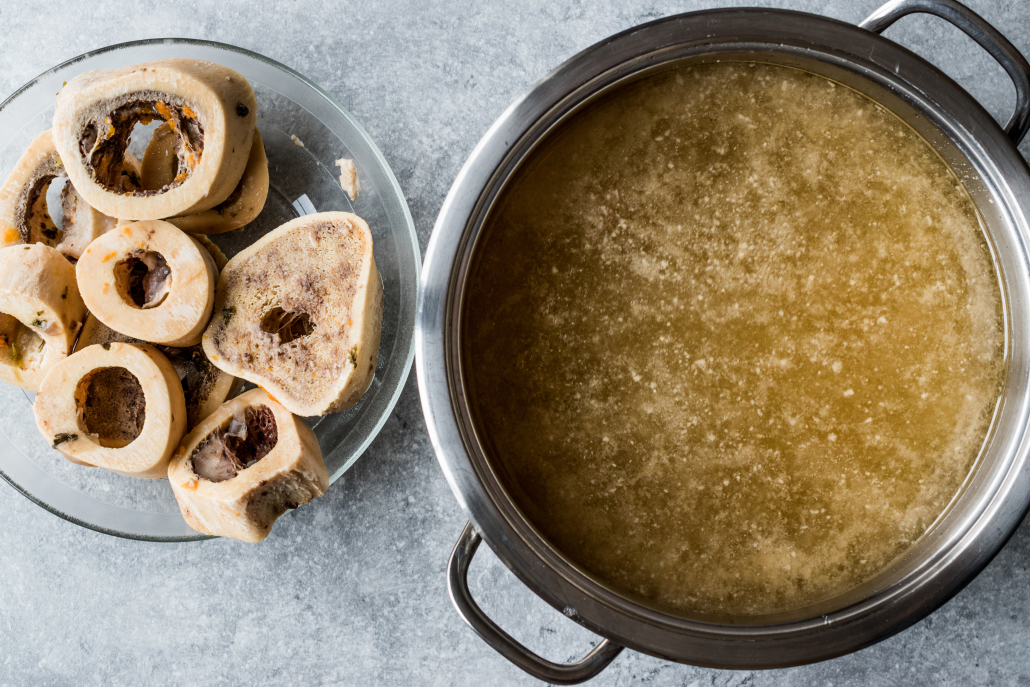
Bone broth and bone marrow are both staple foods across most early cultures. Modern nutritional research shows us why: these foods are nature’s best source of glycine, the most anti-inflammatory, anti-aging amino acid. Bone-derived food products are high in fat, free of carbs, and keto-friendly.
Bone broth and bone marrow are also excellent sources of collagen that supports healthy skin and bones. Research has found that supplementing your diet with collagen may improve skin health and reduce aches and pains.
| Nutrient | 100g of Bone Marrow | Recommended Daily Value (RDV) | %RDV |
| Calories | 770 calories | 2,500 calories | 30% |
| Protein | 7 grams | 50 g (standard diet, not keto) | 14% |
| Fat | 80 grams | 30 g (standard diet, not keto) | 266% |
| Carbohydrates | 0 mg | 120 g (standard diet, not keto) | 0% |
| Niacin | 0.4 mg | 16 mg | 3% |
| Selenium | 20 mcg | 70 mcg | 36% |
| Iron | 0.8 mg | 20 mg | 4% |
| Magnesium | 1.8 mg | 420 mg | 0.4% |
| Zinc | 0.1 mg | 11 mg | 1% |
| Potassium | 137 mg | 4000 mg | 5% |
| Phosphorus | 7 mg | 700 mg | 1% |
Eggs
Eggs are a commonplace, convenient animal product — which makes them perfectly suited to the carnivore diet.
With a wide blend of healthy fats, proteins, vitamins, and minerals, eggs are a whole-animal food that contains almost everything your body needs.
The choline content of eggs also makes them great for women who are pregnant or trying to become pregnant.
| Nutrients | 100 grams (appx 2 eggs) | %Daily Value |
| Calories | 140 | |
| Fat | 10 | 16% (Not on Ketogenic Diet |
| Protein | 12 | |
| Vitamins and Minerals | ||
| Retinol (vitamin A) | 98mcg | 12% |
| Riboflavin | 0.4mg | 33% |
| Thiamin | 0.05mg | 5% |
| Vitamin B6 | 0.02mg | 2% |
| Vitamin B12 | 0.33mcg | 100% |
| Biotin | 5.2mcg | 17% |
| Folate | 88mcg | 30% |
| Vitamin D | 7.9mcg | 30% |
| Vitamin E | 1.9mg | 30% |
| Pantothenic acid | 1.07mg | 22% |
| Potassium | 131mg | 3.5% |
| Magnesium | 12mg | 3% |
| Phosphorus | 171mg | 25% |
| Iron | 1.8mg | Men (23%) Women (10%) |
| Selenium | 28mcg | 50% |
| Zinc | 1.0mg | 10% |
| Iodine | 47mcg | 33% |
Finding the Best Quality Eggs
As you can see in the chart above, eggs, especially the yolks, are loaded with healthy fats and powerful nutrients.
These nutrients are found in greater abundance in the highest quality eggs laid by happy healthy hens raised outdoors. Here are a few tips for finding the highest quality eggs, as well as some marketing gimmicks to watch out for.
Brown or White Eggs?
There’s no difference between the nutrients in brown or white eggs. The only thing setting them apart is the breed of the hen laying them. So, color is not a criterion for choosing healthy eggs.
Egg Grades?
Grade AA, A, and B have no real nutritional meaning and refer only to the firmness of the egg whites and the roundness of the yolks. You can get super nutritious grade B eggs at a farmer’s market from hens roaming around eating actual worms and other critters. While at the same time, you can get nutritionally unimpressive grade AA conventional eggs from the supermarket. So again, not a factor for choosing healthy eggs.
Vegetarian-Fed
Chickens are natural omnivores, evolved to live off grubs, worms, and insects, as well as grass ad grains. In order to be vegetarian-fed, chickens have to be kept in cages. The vegetarian feed is usually GMO corn. Like humans, chickens aren’t meant to be vegetarians.
Organic Eggs
Organic eggs are certified and inspected to be free of pesticides and antibiotics. The chickens usually live in barns, and have to have at least some access to the sun–even if just through a small window. Organic doesn’t necessarily mean that they can go outside.
Omega-3 Eggs
These eggs have enhanced Omega-3s due to the hens being fed flaxseed. The debate is out on these. Since eggs are already high in omega-3s it’s not really necessary. And as part of a carnivore diet you really don’t need extra omega-3s.
Pasture Raised
The healthiest eggs are from pasture-raised hens. Yet this term isn’t enforced by the USDA. If an egg carton says both pasture-raised and has the “Certified Humane” or “Animal Welfare Approved” stamps, this means each hen had at least 108 square feet of outdoor space, in addition to indoor barn space. Other claims like “cage free” and “natural” are unregulated and don’t mean anything.
Farmer Eggs
To get the very healthiest eggs, get to know the egg providers at your local farmer’s market. Ask them what they feed their hens and how they’re raised. If they roam around the farm feasting on insects and grass, you’ve hit the healthy egg jackpot.
Dairy on Your Carnivore Diet Food List
The place of dairy on your carnivore diet food list can be a bit controversial. On the one hand, a lot of people have dairy sensitivities. These can show up as bloating, constipation, and other digestive problems. They can also be expressed externally as psoriasis and eczema.
If you’re considering the carnivore diet as a way to treat these issues, we recommend eliminating dairy for 30-60 days before putting it back on your list.
If you’re good with dairy, go for the creamiest options. Creamy blue cheese offers numerous benefits thanks to naturally occurring beneficial palyamines.
A2 vs. A1 Dairy
Have you seen A2 listed on a milk carton and wondered what it meant?
A2 refers to one of two types of milk protein (casein). Most cows’ milk has A1 proteins which break down into beta-casomorphin 7. This molecule has been linked to cardiovascular and autoimmune disease.
A2 milk protein is broken down differently and can be found in all goat, sheep, buffalo milk, even when not labeled A2.
When choosing the best butter and ghee for your carnivore diet food list, opt for grass-fed varieties.
As with most dairy, cheese is likely best eliminated during the early stages of the carnivore diet.
When re-introducing cheese, stay attuned to your body to see how it responds. If bloating occurs, best to leave it out entirely.
Nutrition info per 100 grams
| Type of Dairy | Calories | Fat | Protein | Carbs | % Calories from fat | % Calories from protein | % Calories from carbs |
| Ghee | 896 | 104 | .3 | 0 | 100 | 0 | 0 |
| Butter | 714 | 84 | .8 | .01 | 99.9 | .01 | 0 |
| Creme fraiche | 403 | 43.2 | 2.4 | 2.4 | 96 | 2 | 2 |
| Heavy cream (3.3 oz) | 333 | 36.3 | 2.8 | 2.7 | 94 | 3 | 3 |
| Cream cheese | 352 | 34.5 | 6.2 | 5.5 | 87 | 7 | 6 |
| Sour cream | 192 | 18.4 | 2.3 | 4.5 | 86 | 5 | 9 |
| Cheddar cheese | 414 | 33.8 | 23.4 | 3.2 | 74 | 23 | 3 |
| Full Fat Greek Yogurt | 100 | 5.1 | 9.5 | 4.1 | 47 | 37 | 16 |
Creme Fraiche Highlights
Think of creme fraiche as the refined French cousin to American sour cream. Creme fraiche literally means fresh cream–but like sour cream it’s cultured. Its flavor is less tangy, however.
And because it has very high butterfat content it won’t curdle or break down when added to hot or acidic food–instead, it will melt creamily.
Creme fraiche makes a great addition to eggs, backed and scrambled, and to baked salmon dishes to up the fat content and give it that je ne sais quoi.
Beverages on your Carnivore Diet Food List
For the strictest carnivore dieters, the beverages on a carnivore diet food list is short: water.
But for the rest of us mere mortals, coffee, tea, milk, cream, and bone broth can all make regular cameos.
Since your body will be running on fat for fuel, if you can tolerate dairy well, load up your coffee or tea with heavy cream or add some butter.
Take it a step further and enjoy a cold cup of heavy cream on its own.
A heavy-cream matcha or coffee lattes are like grown-up milkshakes.
Controversial Topics
Sauces
Most store-bought sauces are based in seed oils and loaded with sugars. So best to avoid all sauces other than those you make yourself. Some carnivore-friendly sauces can be found in the French canon–Béarnaise and Beurre Blanc are almost pure butterfat.
Snacking
How often you eat on a carnivore diet is really up to you. But most people find that whole animal foods with plenty of healthy fats are extremely satiating. And if you’re keto adapted you won’t have the kind of blood-sugar roller coaster that keeps you craving carbs.
We find that the benefits of a carnivore diet are enhanced by intermittent fasting. Eating two meals a day within a 6-hour window appears to be the metabolic sweet spot for many people.
Most Nutrient Dense Carnivore Foods
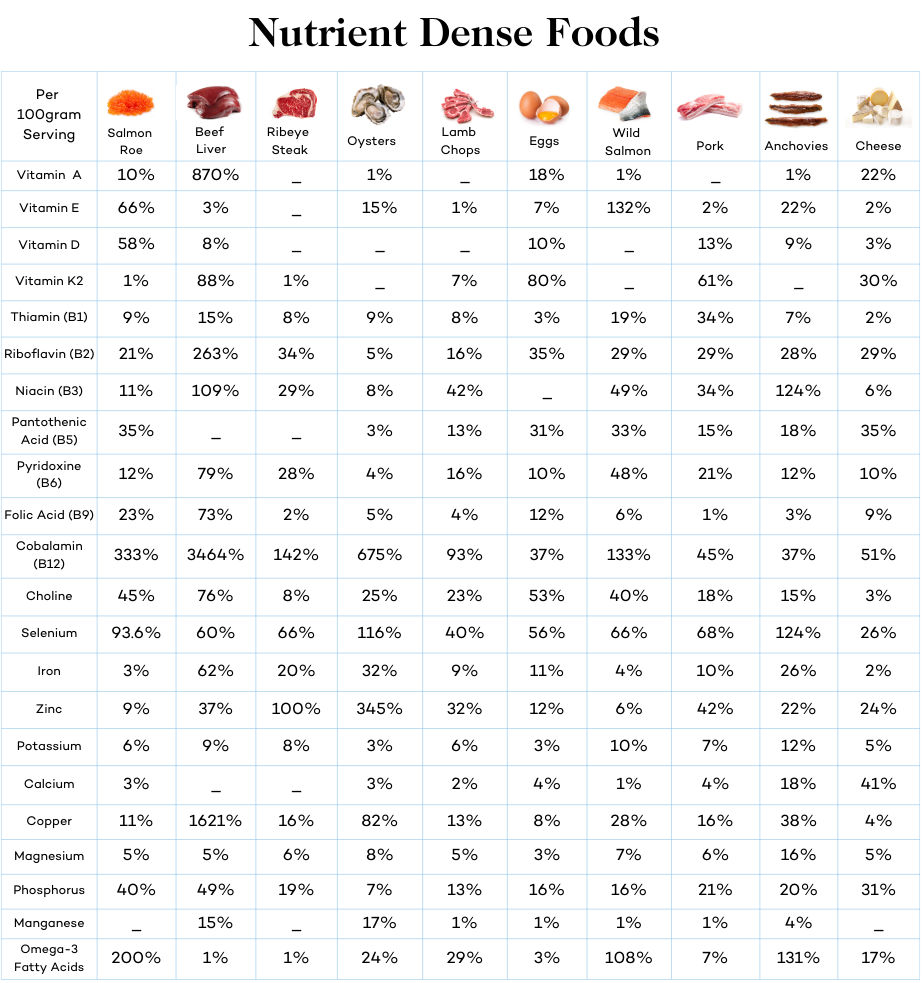
The Best Ways to Source Carnivore Foods
Finding premium animal products for your carnivore diet is easier than you might think. Here are several of the best sourcing options.
Your local butcher
Nobody will be more supportive of your carnivore diet more than your local butcher. Butchers have a comprehensive knowledge of the different cuts of meats. If you’re buying in bulk, they’ll probably be more than happy to cut you a deal.
Farmers Market
Local farmers’ markets are also a great place to find premium animal products. Many markets feature everything you need to eat carnivore, including eggs, organ meats, grass-fed dairy, honey (yes, honey is an optional carnivore food), and more. Another benefit: the food you’ll find at a farmer’s market is more than likely super fresh.
Supermarkets
If all else fails, your local supermarket carries plenty of carnivore-friendly foods. While organ meats and salmon roe may not be available, muscle meat is easy to find–opt for the fattiest cuts! Your supermarket will also carry plenty of good cheese options — just be sure to pick something that’s free of additives.
Buy online
It’s true — in 2021 you really can buy premium meat online. Dr. Kiltz recommends Butcher Box, a 100% grass-fed, grass-finished beef delivery site.
Putting This Carnivore Food List to Work
To put this carnivore food list to work, head on over to our carnivore diet meal plan to follow our 7 day menus and shopping lists.













